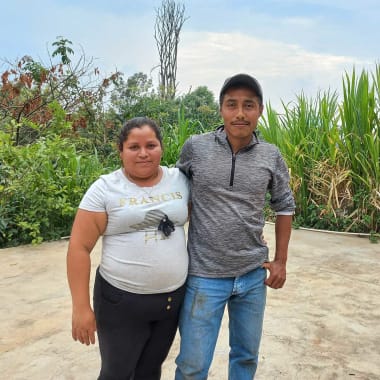-
Producer
-
Mynor Edelmiro Lope Carrillo
-
Country
- Guatemala
-
Region
-
Huehuetenango
-
Altitude
-
1480m above sea level
-
Variety
-
Process
-
Body
-
-
Acidity
-
-
Tasting notes
-
Hazelnut, shortbread and fig
-
Roast style
Guatemala
Finca Los Cipreses
Los Cipreses is located in the remote village of El Coyegual in San Antonio Huista in northern Guatemala, very close to Mexico. We taste hazelnut, shortbread and fig.
An elegant, bright cup that celebrates the journey of this self-made Guatemalan coffee grower.
The farm Los Cipreses is located in the remote village of El Coyegual in San Antonio Huista in northern Guatemala, very close to Mexico. Mynor Edelmiro inherited it sixteen years ago when his father emigrated to the United States in search of a better life. A very young fellow then, he decided to drop out of school to manage the farm, build his own future and preserve the family’s legacy.
At the time, the land served only as cattle and horse paddocks, but he decided to grow coffee, grains and lemons. Today, he grows mainly Caturra (this lot) and a little bit of Bourbon. Mynor Edelmiro manages all the work but hires local workers for certain activities, such as fertilizing, pruning and picking during harvest time. In the off-season months, he still works with cattle, which provides a secondary source of income.
Only two years ago, Los Cipreses started producing specialty-grade coffee as a result of all the improvements he learned through Caravela Coffee’s PECA—which stands for “Programa de Educación para el Caficultor” and translates as Coffee Grower Education Program". The initiative aims to “continuously educate producers and their families on best practices to increase productivity and improve quality so they can be more profitable.”
His latest modifications were made during the drying and fermentation processes, and the results are visible in this graceful lot. On the next harvest, he plans to experiment with longer fermentation times and elevate the quality of water used in the washed process.
Edelmiro, who lives with his wife Ana Leticia, says that growing coffee hasn’t been easy, but he is proud of the grower he’s become and the product he’s offering. We’re proud of him, too, and we feel grateful for having his beans with us.
Certifications: PECA
All the images and information about this coffee and producers have been kindly shared by its importer, Caravela Coffee, and edited by us, Sample Coffee (unless linked to or credited otherwise).
Our new recommended brewing window for peak flavour is within days ~10-50 post-roast date.
We’ve recently changed into a Loring Kestrel S35 coffee roaster, which uses a different roasting technology from our previous one. Aside from reaching more nuanced and transparent flavours, we’ve noticed a change in our beans’ aging behaviour. Brewing between days ~10-50 post-roast seems to bring out the best of each coffee, but it may taste fine if you do it earlier or even a few days later. Test, try and adjust to find what works for you!
PS. Please note our packaging still shows our old recommendation. This will change in our next printed batch!
Need any brewing tips?
Head to our brew guides and find your favourite filter method—or head straight to our single origin espresso recipe. If you have further questions, send us an email. We’re always keen to help.
Learn everything about this coffee:
Ethical, traceable sourcing
This page has all the sourcing information (variety, process, region, story, importer, and more) that our importers share with us, and give us permission to use.
The transparency helps us talk confidently about the quality and background of our product, and it helps you know exactly what you’re buying.
Learn more:
Coffee page transparency legend
Our coffee philosophy
Our business approach
Fresh harvest coffee
We only source and roast coffee from each country’s latest harvest season (so the green coffee is never older than 1 year from the time of picking, processing and packing). This ensures the sensory qualities are always at their peak and unaffected by excessive ageing.
Roasted for espresso and filter (best enjoyed black)
Roast style: omni. Omni roasts are designed to brew and taste great both as espresso and filter. Our omni single origins generally sit on Agtron values in the ~70-60 value range. So, technically, they are somewhere in the lighter side of the medium spectrum.
Designed for espresso and filter brewing. Best enjoyed black.
Learn more:
Our Loring Kestrel S35 roaster
Our roasting style and approach
Best brewed within days 15-49 post-roast
The ‘fresh is best’ saying doesn’t apply to coffee (contrary to popular belief). Waiting before opening and brewing your bag of whole coffee beans helps develop peak flavour and acidity.
But heads up: if you buy pre-ground coffee, brew it as soon as possible.
Learn more:
Our recommended brewing window
Try our custom brewing recipes
Our recipes and ratios are tailored to our coffee sourcing and roasting styles, bringing the best flavour and feel out of each coffee.
For pour over, immersion, and other filter brewing styles, check our brew guides.
For our espresso single origins, we recommend a coffee:yield ratio of 1:3:
- Dose: 20g ground coffee
- Yield: 60g espresso
- Total brew time: ~24-28 seconds
This is just a starting point! We encourage you to experiment, taste, and adjust to find the recipe that you enjoy the most.
Learn more:
Our espresso brew guide (single origin)
Brewing ratio calculator
Packaging and sustainability
- Bags: ABA-certified home compostable (AS 5810-2010)
- Labels: recyclable
- Valves (only on +250g bags): general waste
- Box and tape (online orders): recyclable
Learn more:
Our packaging
Variety
Caturra variety
Caturra is a natural mutation of Bourbon that was originally discovered in Brazil in 1937, considered to be the first naturally occurring mutation ever discovered.
The location
Coffee from Guatemala
Guatemala’s production of coffee first grew in the 1860s on the back of a declining indigo trade, which had previously existed as it’s main export. Up until 2011 Guatemala was in the top 5 highest producing coffees nations in the world, before being overtaken by Honduras.
Farm processes
Washed process
Machines are used to remove the flesh from the coffee cherry before being fermented in water, washed again, and finally sun dried. This process tends to result in more distinct, cleaner flavours.
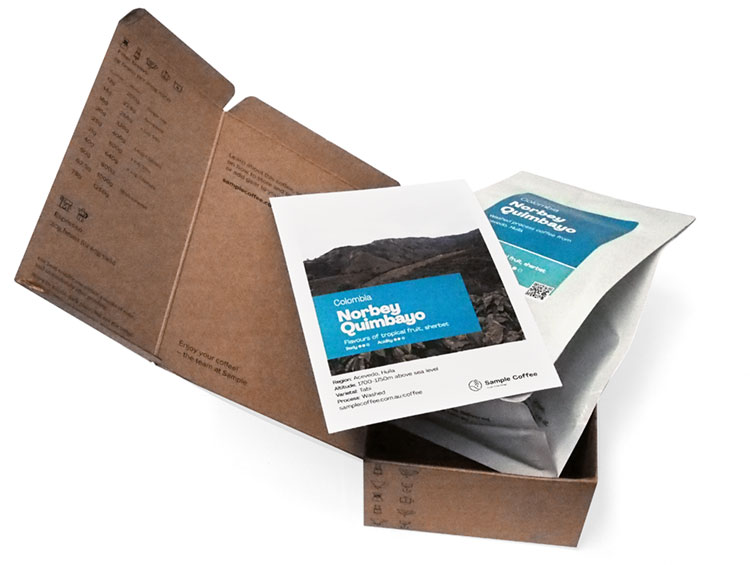
Subscribe to a world of coffee
Discover a new single origin coffee from Sample every 1-5 weeks with no delivery fees.
No up-front purchase, and you can pause, cancel, or change plans at any time.
Available to order online this week:
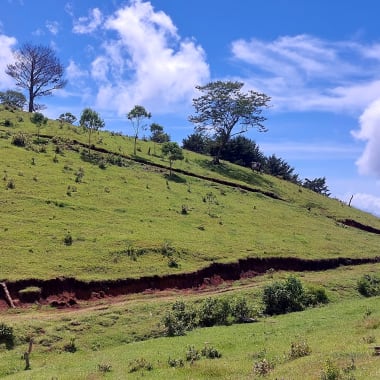
El Salvador Manuel Castañeda
Flavours of toffee apple, cranberry, dulce de leche
Body Acidity
Honey Pacamara
March 2025 harvest
Roasted omni for filter and espresso
El Salvador Manuel Castañeda online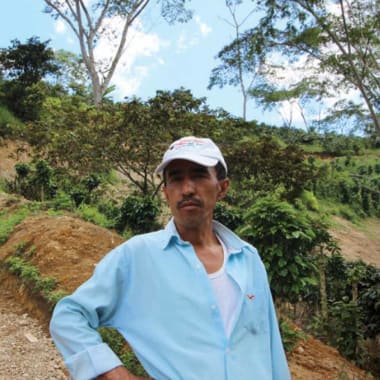
Colombia Jose Elcias Martinez Guzman Pink Bourbon
Flavours of mandarin, burnt orange, pineapple
Body Acidity
Washed Pink Bourbon
December 2024 harvest
Roasted omni for filter and espresso
Colombia Jose Elcias Martinez Guzman Pink Bourbon online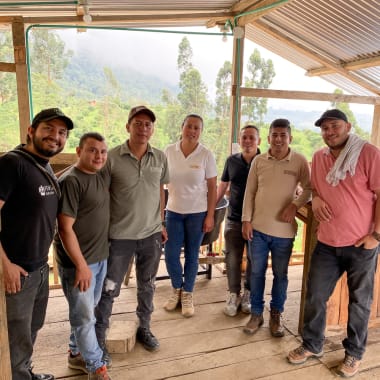
Colombia Adriana Díaz
Flavours of lemongrass, black tea, bergamot
Body Acidity
Anaerobic washed Gesha
Roasted omni for filter and espresso
Colombia Adriana Díaz online
Ethiopia Bekele Gemeda
Flavours of mandarin, white peach, mango
Body Acidity
Washed Ethiopian Heirloom
November 2024 harvest
Roasted omni for filter and espresso
Ethiopia Bekele Gemeda online